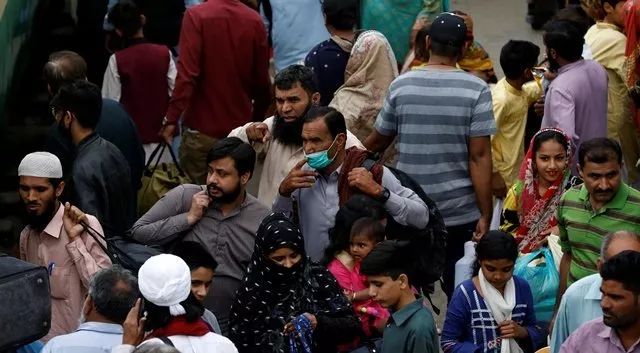Over 57% to suffer Covid financial squeeze
Up to 19.1m jobs at risk because of lockdowns
ISLAMABAD:
Around 57% of the country’s population is economically vulnerable to the effects of the coronavirus pandemic and between 12.5 million to 19.1 million jobs are at stake because of the partial and complete lockdowns imposed to stem the spread of the disease, according to the Economic Survey of Pakistan 2019-20 released on Thursday.
The government also expects a second wave of Covid-19 that “could further threaten macroeconomic stability and socio-economic outcomes”.
The higher public debt, which is currently estimated at 88%, would be “problematic” and financing for development projects might become scarce. Revenue would be difficult to increase and the expenditure demand might be immense.
The government has not given any exact figure about the economic losses suffered because of the pandemic in a special chapter on Covid-19 that is part of the survey, but Finance Adviser Dr Abdul Hafeez Shaikh at a news conference put it at “over Rs3 trillion”.
“It is very difficult to say with certainty but Pakistan’s GDP that was projected to grow over 3% contracted to 0.4% and we have effectively lost 3.5% of the GDP due to coronavirus,” he said while releasing the survey.
“Exports have already dipped while foreign remittances are also going to get affected in the coming months,” he added.
The survey report has discussed the socio-economic assessment in light of economic, social and food security related vulnerabilities.
“An estimated 56.6% of the population is socio-economically vulnerable to the Covid-19 crisis,” the report read.
Women and children, especially those from more disadvantaged households and home-based workers, will be among the worst hit.
Shaikh pinned the blame for all the economic miseries on the spread of the disease.
However, the finance adviser ducked a question about the planning ministry’s assessment that the “prospects for economic growth even before the emergence of the Covid-19 phenomenon were eclipsed by higher inflation and interest rates, negative large-scale manufacturing growth, weaker exports, sluggish resource mobilisation, uncertainty surrounding hot money inflows and, above all, tough International Monetary Fund (IMF) programme–related conditions”.
The special Covid-19 chapter stated that before the outbreak, the economy was projected to grow by 3.3% and due to the pandemic it contracted 0.4% this year. The investment-to-GDP ratio that had been projected at 15.6% of the GDP would remain at 15.4% due to the disease. The public investment has remained unaffected at 3.8% of the GDP in both the scenarios during this fiscal year.
According to the report, the industrial and services sectors were affected the most.
“There is likely to be a big fall in private investment in coming months when faced with industrial closures and the obvious reluctance of the banks to offer loans”, the report read.
“The FBR’s tax collection that was expected to remain at Rs4.8 trillion before Covid-19 would remain below Rs3.9 trillion,” said Shaikh. The official target given by the IMF was Rs5.5 trillion.
According to the report, the expected loss of employment is estimated to be between 12.5 million and 15.5 million in case of a moderate slowdown of economic activities. In case of a severe reduction, these numbers could jump up to between 18.7 million and 19.1 million.
Due to the global economic restrictions, up to 60,000 migrant workers could not proceed abroad while the overseas hiring of another 100,000 people has been halted.
Fearing second wave of disease, the survey underlined that “healthcare facilities are insufficient to meet the population’s need”.
There is only one hospital bed for over 1,680 people. Currently, there are 4.7 million pregnant women in Pakistan and the pandemic will impact the reproductive and child healthcare at multiple levels.
Similarly, Covid-19 has directly impacted 42 million school-going learners from pre-primary to higher secondary and degree college levels. The survey stated that rural areas and urban slums were potentially at highest risk with more than 70% of current enrolments and large pockets of already out-of-school children.
While discussing the food security related issues, about 22% are dependent on daily-wage earners. Similarly, around 62% of households in the poorest wealth quintile rely on farm labour and daily wage as livelihood. Most of the farmers store wheat for household consumptions. Due to the reduced sale of farm produce and related productions and reduction in other non-farm work, might be compelled to sell their wheat stocks.
Small entrepreneurs, shopkeepers and small factory owners and labourers who are directly dependent on income sources from daily trade and economic activities linked to the food and agriculture are also likely to experience a sharp decrease in their earnings.


COMMENTS
Comments are moderated and generally will be posted if they are on-topic and not abusive.
For more information, please see our Comments FAQ